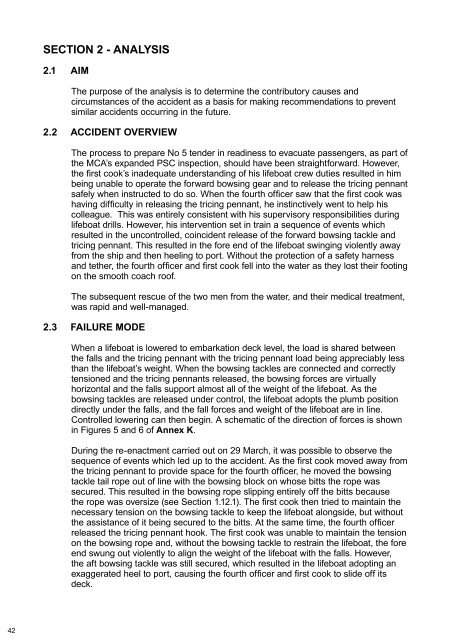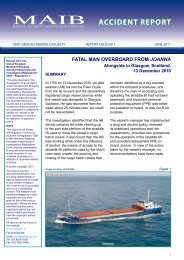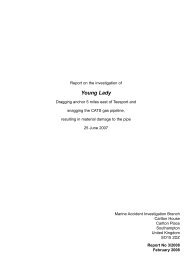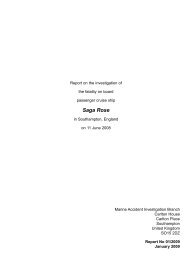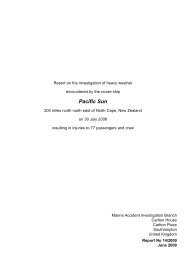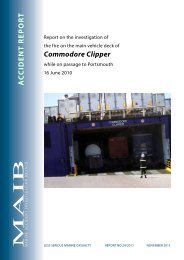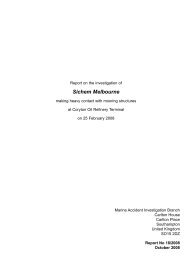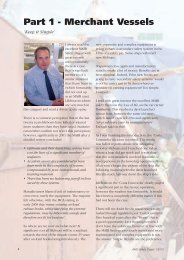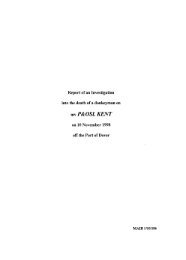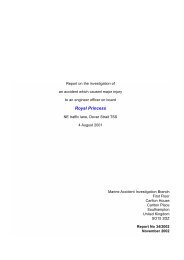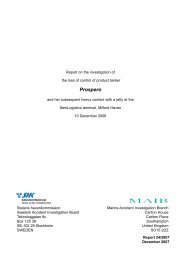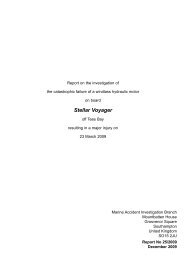SECTION 4 - Marine Accident Investigation Branch
SECTION 4 - Marine Accident Investigation Branch
SECTION 4 - Marine Accident Investigation Branch
You also want an ePaper? Increase the reach of your titles
YUMPU automatically turns print PDFs into web optimized ePapers that Google loves.
42<br />
<strong>SECTION</strong> 2 - ANALYSIS<br />
2.1 AIM<br />
The purpose of the analysis is to determine the contributory causes and<br />
circumstances of the accident as a basis for making recommendations to prevent<br />
similar accidents occurring in the future.<br />
2.2 ACCIDENT OVERVIEw<br />
The process to prepare No 5 tender in readiness to evacuate passengers, as part of<br />
the MCA’s expanded PSC inspection, should have been straightforward. However,<br />
the first cook’s inadequate understanding of his lifeboat crew duties resulted in him<br />
being unable to operate the forward bowsing gear and to release the tricing pennant<br />
safely when instructed to do so. When the fourth officer saw that the first cook was<br />
having difficulty in releasing the tricing pennant, he instinctively went to help his<br />
colleague. This was entirely consistent with his supervisory responsibilities during<br />
lifeboat drills. However, his intervention set in train a sequence of events which<br />
resulted in the uncontrolled, coincident release of the forward bowsing tackle and<br />
tricing pennant. This resulted in the fore end of the lifeboat swinging violently away<br />
from the ship and then heeling to port. Without the protection of a safety harness<br />
and tether, the fourth officer and first cook fell into the water as they lost their footing<br />
on the smooth coach roof.<br />
The subsequent rescue of the two men from the water, and their medical treatment,<br />
was rapid and well-managed.<br />
2.3 FAILURE MODE<br />
When a lifeboat is lowered to embarkation deck level, the load is shared between<br />
the falls and the tricing pennant with the tricing pennant load being appreciably less<br />
than the lifeboat’s weight. When the bowsing tackles are connected and correctly<br />
tensioned and the tricing pennants released, the bowsing forces are virtually<br />
horizontal and the falls support almost all of the weight of the lifeboat. As the<br />
bowsing tackles are released under control, the lifeboat adopts the plumb position<br />
directly under the falls, and the fall forces and weight of the lifeboat are in line.<br />
Controlled lowering can then begin. A schematic of the direction of forces is shown<br />
in Figures 5 and 6 of Annex k.<br />
During the re-enactment carried out on 29 March, it was possible to observe the<br />
sequence of events which led up to the accident. As the first cook moved away from<br />
the tricing pennant to provide space for the fourth officer, he moved the bowsing<br />
tackle tail rope out of line with the bowsing block on whose bitts the rope was<br />
secured. This resulted in the bowsing rope slipping entirely off the bitts because<br />
the rope was oversize (see Section 1.12.1). The first cook then tried to maintain the<br />
necessary tension on the bowsing tackle to keep the lifeboat alongside, but without<br />
the assistance of it being secured to the bitts. At the same time, the fourth officer<br />
released the tricing pennant hook. The first cook was unable to maintain the tension<br />
on the bowsing rope and, without the bowsing tackle to restrain the lifeboat, the fore<br />
end swung out violently to align the weight of the lifeboat with the falls. However,<br />
the aft bowsing tackle was still secured, which resulted in the lifeboat adopting an<br />
exaggerated heel to port, causing the fourth officer and first cook to slide off its<br />
deck.


